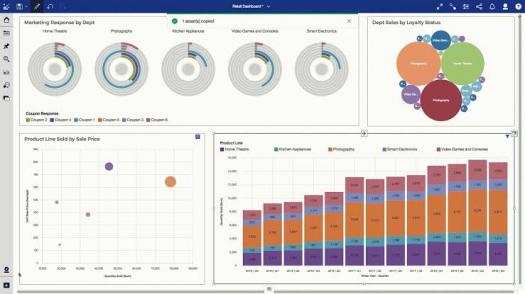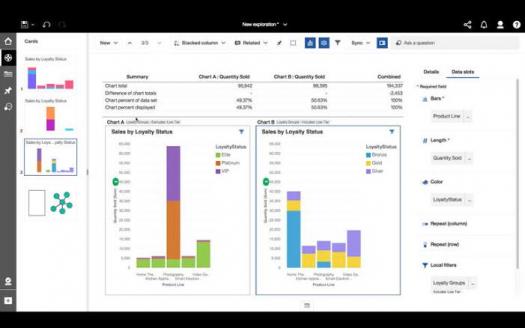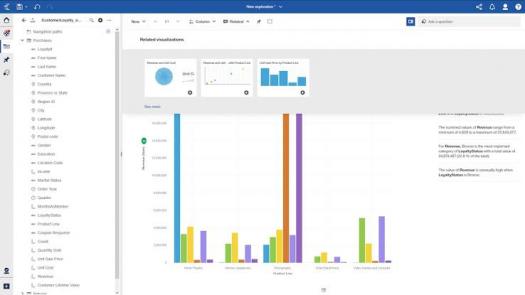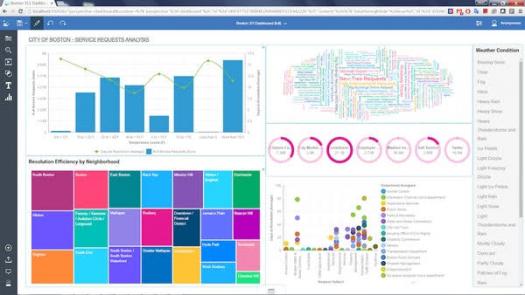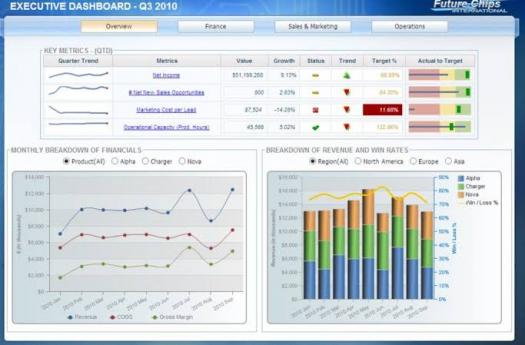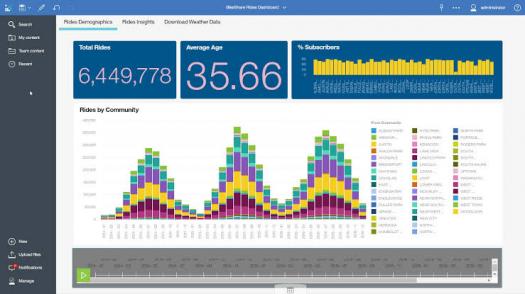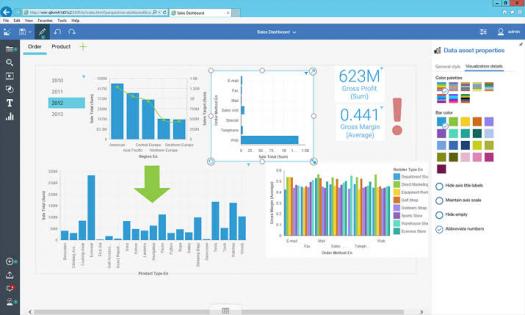Can You Pass This Cognos Test? Trivia Quiz.
-
What can be done when using a SQL object when not using a stored procedure?
-
Delete rows in a database.
-
Insert rows into database.
-
Select rows from a database
-
Update a database.
-
Cognos has been in existence for a while now. In 2008, IBM acquired it. Today, Cognos is used by various companies all around the world to test the performance management of their employees. The software is one of the best performance testing software. This quiz will test how vast your performance knowledge is using Cognos.

- 2.
A report author creates the following filter in a report: [Region] in (' Americas',' Asia Pacific') Which type of filter was created?
-
Advanced
-
Parameterized
-
Custom based on data item
-
Combined
Correct Answer
A. ParameterizedExplanation
The filter created in the report is a parameterized filter. This is evident from the use of the ampersand (&) symbol before the list of values ('Americas', 'Asia Pacific'). Parameterized filters allow the report user to select values from a predefined list, in this case, the regions 'Americas' and 'Asia Pacific'.Rate this question:
-
- 3.
How can an Uploaded file be combined with data from a database?
-
Use a Master detail relationship.
-
Include the Uploaded file and a package as a Data source to the report
-
Create a Data module.
-
Nest a List using the Uploaded file with another List from a package
Correct Answer
A. Create a Data module.Explanation
Creating a Data module allows for combining data from multiple sources, including an uploaded file and a database. This will enable the user to access and manipulate data from both sources within the same module, providing a comprehensive view of the data for reporting purposes.Rate this question:
-
- 4.
A report author wants to display the report name on the report page. Which type of calculation should be used?
-
Layout calculation
-
Query calculation
-
Singleton
-
Field se
Correct Answer
A. Layout calculationExplanation
A layout calculation should be used to display the report name on the report page. Layout calculations are used to perform calculations and display the results within the layout of a report. In this case, the report author wants to display the report name, which is a static value and does not require any calculations based on data from the query. Therefore, a layout calculation is the appropriate choice to achieve this requirement.Rate this question:
-
- 5.
Which statement is true about using a burst key to burst reports?
-
A burst key can be added to a crosstab report.
-
A burst key can be added to a map report.
-
A burst key can be added to a chart report.
-
A burst key can be added to a list report.
Correct Answer
A. A burst key can be added to a list report.Explanation
A burst key can be added to a list report, allowing the report to be bursted or split into multiple reports based on a specific key value. This feature is useful when there is a need to distribute the report to different recipients based on certain criteria, such as region or department. By adding a burst key to a list report, each recipient will receive a customized report containing only the data relevant to them.Rate this question:
-
- 6.
In Report Studio, an author creates a list report containing columns for Staff Name, Order number, and Revenue. The author wants to burst this report to various sales staff members. Each member should see only data relating to sales they have made. What must the author do to specify that the burst report output will contain only data for the appropriate sales staff member?
-
In the burst options for the report, use the Staff Name data item to specify the Burst Groups.
-
In the burst options for the report, use the Staff Name data item to specify the Burst Recipients.
-
In the report layout, create a master-detail relationship on the Staff Name data item.
-
In the report layout, add the Staff Name data item as a property of the List object.
Correct Answer
A. In the burst options for the report, use the Staff Name data item to specify the Burst Groups.Explanation
The author must use the Staff Name data item to specify the Burst Groups in the burst options for the report. This means that the report will be bursted and divided into separate groups based on the Staff Name. Each sales staff member will receive a report containing only the data relating to the sales they have made.Rate this question:
-
- 7.
An author creates a report for bursting. In Report Studio, the author sets the burst type for the report to Directory entries. In Cognos Connection, the author sets the run options to burst the report and send the report by email. If the email addresses for the burst recipients are accessible by IBM Cognos BI, what is the expected result?
-
A warning message appears indicating a conflict in the run options.
-
The report is burst to both email addresses and directory entries.
-
The report is burst to directory entries only.
-
The report is burst to email addresses only.
Correct Answer
A. The report is burst to both email addresses and directory entries.Explanation
The author has set the burst type for the report to Directory entries and has also set the run options to burst the report and send it by email. Since the email addresses for the burst recipients are accessible by IBM Cognos BI, the expected result is that the report will be burst to both the email addresses and the directory entries.Rate this question:
-
- 8.
In Report Studio, an author creates a weekly sales report and modifies the global class setting in the report. Which reports will this modifications affects?
-
All reports
-
Report created using the same package
-
Reports created within the log on section
-
Only the current report
Correct Answer
A. Only the current reportExplanation
The modifications made to the global class setting in Report Studio will only affect the current report. This means that any changes made to the global class setting will not impact other reports, reports created using the same package, or reports created within the log on section. The modifications are specific to the report in which they were made.Rate this question:
-
- 9.
In a Report Studio, an author wants the report title to appear in the language in which the report is run. What property of the report header must the author define to create this variable?
-
Style Variable
-
Text Source Variable
-
Render Variable
-
String Variable
Correct Answer
A. Text Source VariableExplanation
To have the report title appear in the language in which the report is run, the author must define a Text Source Variable in the report header. This variable allows the author to dynamically change the text displayed based on the language selected for the report. By using a Text Source Variable, the report title will automatically update to the appropriate language when the report is run.Rate this question:
-
- 10.
In Report Studio, for which task would an author create a query calculation?
-
Derive additional information from data source
-
Let users choose which filter to apply to a report
-
Add report run-time information a report
-
None of the above
Correct Answer
A. Derive additional information from data sourceExplanation
An author would create a query calculation in Report Studio to derive additional information from the data source. This means that the author can perform calculations or transformations on the data to generate new insights or metrics that are not directly available in the original data. By creating a query calculation, the author can enhance the analysis and reporting capabilities of the report by including derived information that is relevant to the analysis being performed.Rate this question:
-
Quiz Review Timeline (Updated): Mar 18, 2023 +
Our quizzes are rigorously reviewed, monitored and continuously updated by our expert board to maintain accuracy, relevance, and timeliness.
-
Current Version
-
Mar 18, 2023Quiz Edited by
ProProfs Editorial Team -
Jun 27, 2019Quiz Created by
AdewumiKoju
 Back to top
Back to top



![A report author creates the following filter in a report: [Region] in (' Americas',' Asia Pacific') Which type of filter was created? A report author creates the following filter in a report: [Region] in (' Americas',' Asia Pacific') Which type of filter was created? - ProProfs](https://media.proprofs.com/images/QM/user_images/2356735/1562077344.jpg)
